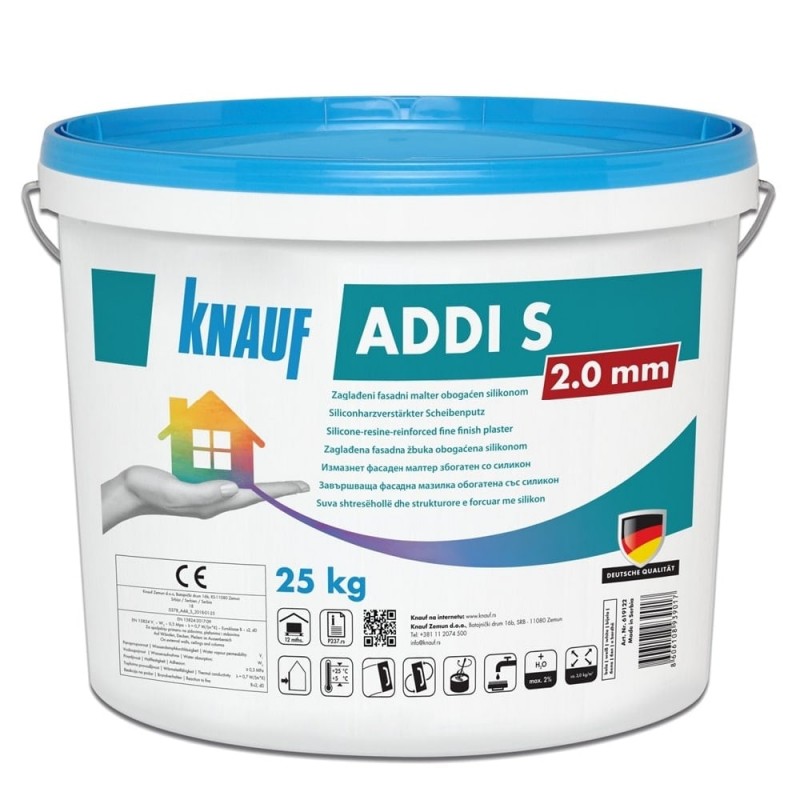ADDI is a specially formulated facade plaster, enriched with silicone and ready for immediate application. This plaster can be diluted with water, making it extremely easy to apply. It is specifically designed for use in contact facade systems, which include thermal insulation boards made of EPS (Expanded Polystyrene) or mineral wool.
Composition:
The composition of ADDI includes various components, including dispersion resin, silicone, specially selected fillers, water, preservatives, and pigments. These ingredients are combined in proportions that provide not only high durability and resistance to atmospheric influences but also easy application and excellent adhesion to different surfaces. Additionally, the silicone adds additional protection and water-repellent properties to the plaster.
Technical data:
- Fire reaction: B-s2, d0
- Material density: Approximately 1800 kg/m³
- Vapor permeability: V1, high
- Water resistance: W2, medium
- Absorbency: ≥ 0.3 MPa
- Durability (frost resistance): w ≤ 0.5 kg/(m²∙h^0.5)
- Thermal conductivity: λ = 0.7 W/(m∙K)
Storage and transportation:
It should be protected from cold, high temperatures, and direct exposure to sunlight. The product should be stored in its original packaging, in a cool but frost-protected place (at temperatures from +5°C to +25°C), with a shelf life of 12 months.
Quality:
The product undergoes constant quality control and bears the CE marking.
Preparation of the substrate:
Before starting work, all surfaces that may become soiled should be protected. Freshly applied layers should be protected from moisture, rain, overly rapid drying due to direct sunlight exposure, and strong winds, by taking appropriate protective measures, such as using tarps on construction scaffolding. The substrate must be load-bearing, dry, flat, and free from grease.
Before use, the load-bearing capacity and compatibility with the ADDI product and existing substrate materials, such as paints or old plasters, should be tested. If necessary, they should be removed. Before applying the material, the substrate must be completely dry.
Substrate materials (or layers) that are not completely dry can cause damage to materials applied on them. The substrate with applied Knauf Quarzgrund must dry for at least 12 hours before applying the facade plaster. The primer should be tinted in an appropriate color, approximately the same as that of the finishing facade plaster.
Execution:
Before starting to apply the material, make sure that the shade is suitable. When tinting the facade plaster, use only material from the same batch/delivery. If the material is from different batches/deliveries, it must be mixed and stirred well beforehand. Before use, stir the material with a mixer until it forms a homogeneous mixture.
The consistency can be improved by adding a small amount of water, and application should be done with a stainless steel trowel. Immediately after application, the material should be evenly structured and without interruptions using a plastic trowel. The type of tool used may affect the structure of the material, so it is recommended to use the same tool throughout the application process. If necessary, the finishing facade plaster ADDI can be colored with the corresponding Knauf facade paint. To avoid "transitions," the work should be carried out by a sufficient number of applicators on all working levels across the entire scaffold so that the facade plaster is applied "wet on wet." Immediately after use, the tool should be thoroughly cleaned with water.
Drying time:
Under ideal conditions, the drying time of the material is one (1) day for every 1 (mm) thickness of the material. In the presence of adverse external temperatures and humidity, the drying time is extended. Under favorable climatic conditions, the material will fully dry after 14 days.
Working temperature:
The material should not be applied at air and substrate temperatures below +5°C and above +25°C. It should not be applied to heated surfaces.
